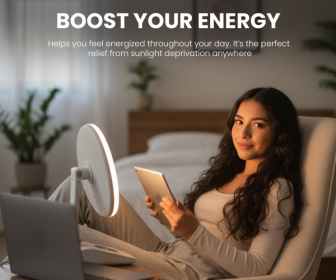🌿 From Stress to Light: Reclaiming Balance in a World That Never Stops

At Aikkiya, we believe peace begins within. Learn more about our commitment to promote peaceful diversity and how it connects wellness with democracy.
Red light therapy for stress relief is more than a wellness trend — it’s part of a growing scientific understanding of how light can restore balance to body and mind. In today’s overstimulated world, we speak endlessly about peace — yet we often neglect its most immediate battleground: the mind.
As Aikkiya reminds us, peace is not only the absence of conflict; it’s the presence of balance — within our communities, our relationships, and our own bodies.
Still, the pace of modern life pushes many into a constant state of tension. Research shows that chronic stress quietly reshapes the brain, narrowing our ability to think creatively and respond with empathy (McEwen, 2017; Byron et al., 2010). The very qualities needed for cooperation and peace — patience, imagination, compassion — are the first to fade when we are exhausted.
The Science of Stress and Creativity
Stress has long been misunderstood as merely emotional fatigue, but neuroscientist Bruce McEwen (2017) described it as a biological process that, when prolonged, causes “an imbalance of neural circuitry subserving cognition, decision-making, anxiety and mood.” In simpler terms: when stress becomes chronic, our brains lose flexibility.
A meta-analysis of 76 experimental studies confirmed that high, uncontrollable stress sharply decreases creativity, while moderate, manageable pressure can sometimes enhance it (Byron et al., 2010). Balance — not intensity — drives human ingenuity.
Yet modern life rarely grants that balance. We are perpetually “on,” overstimulated by information and under-rested. Over time, this erodes not just productivity, but empathy — the cornerstone of peacebuilding.
Where Light Meets Healing
Emerging research suggests a biological path back to clarity. Scientists are discovering that specific wavelengths of red and near-infrared light can stimulate mitochondria — the cell’s powerhouses — improving energy production, blood flow, and even cognitive function.
A 2023 review in the Journal of Translational Medicine found that photobiomodulation (PBM) can enhance attention, memory, and executive functioning through non-invasive light exposure (Pan et al., 2023). Near-infrared light at 800–1,000 nm penetrates the skull, triggering neuroprotective processes and increased ATP production — helping neurons recover from stress and fatigue.
In essence, light — long used as a metaphor for hope — now finds validation in neuroscience.
Explore Mvolo’s collection of red-light lamps designed to restore balance and energy:
From Reflection to Action
At Aikkiya, we explore the intersection of science, wellness, and peace. The pursuit of equilibrium — whether through mindfulness, community, or innovative therapies — is part of building a world where compassion endures.
That’s why we’ve chosen to collaborate with Mvolo, a trusted Dutch wellness brand offering high-quality red-light therapy devices — from portable panels to LED masks and sauna blankets. Their work reflects a simple but powerful idea: healing and harmony begin with light.
Transparency and Purpose
When you purchase Mvolo products through links on our site, Aikkiya receives a small commission at no extra cost to you. These funds help sustain our educational initiatives and advocacy for democracy, mental health, and peaceful coexistence.
We uphold transparency because ethical partnerships are part of the peace we promote.
Want to support our work? Join Aikkiya’s community and be part of a movement for balanced, inclusive peace.
Closing Light
In times of chaos, light remains our oldest symbol of renewal. From the sun rituals of ancient civilizations to today’s gentle red-light glow, illumination continues to remind us that healing begins within.
Whether through quiet meditation, a walk in nature, or the subtle warmth of light therapy — reclaiming calm is not escapism. It is preparation for empathy. It is the work of peace.
References
Byron, K., Khazanchi, S. & Nazarian, D. (2010). The relationship between stressors and creativity: A meta-analysis examining competing theoretical models. Journal of Applied Psychology, 95(1), 201–212. https://doi.org/10.1037/a0017868
McEwen, B.S. (2017). Neurobiological and systemic effects of chronic stress. Chronic Stress, 1, 1–11. https://doi.org/10.1177/2470547017692328
Pan, W-T., Liu, P-M., Ma, D. & Yang, J-J. (2023). Advances in photobiomodulation for cognitive improvement by near-infrared derived multiple strategies. Journal of Translational Medicine, 21, 135. https://doi.org/10.1186/s12967-023-03988-w


This Post Has One Comment
I really enjoyed reading this article. It beautifully shows how real peace starts from within, blending science, wellness, and compassion in such a thoughtful way.